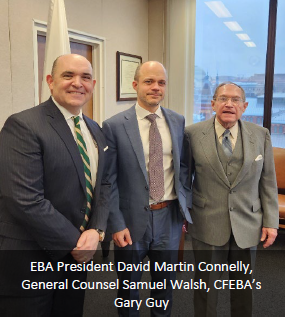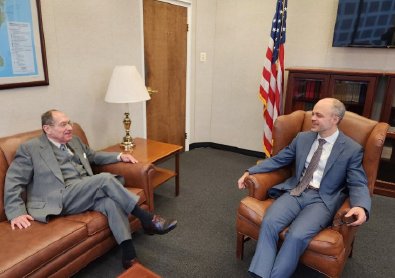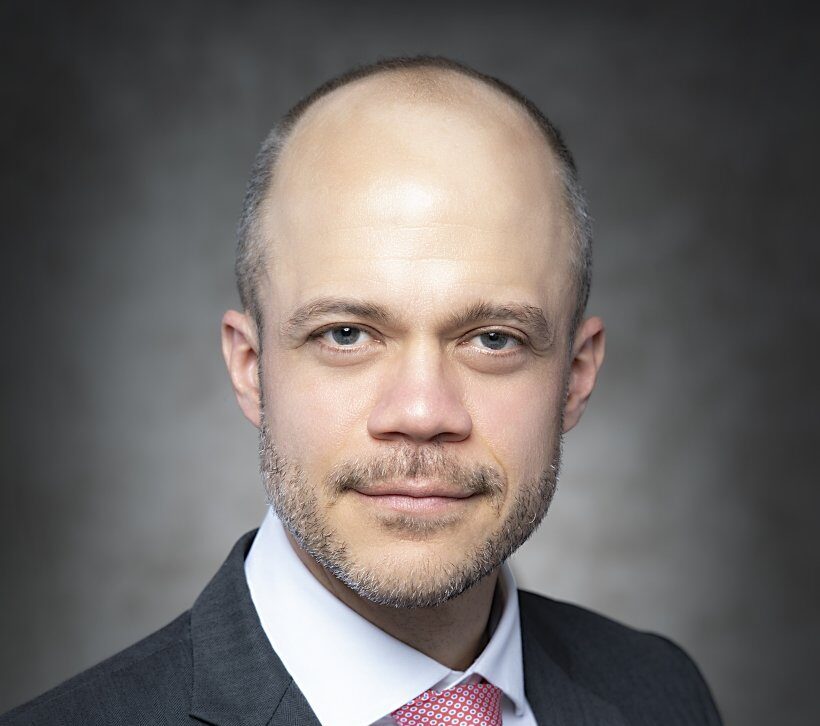By Gary E. Guy and David Martin Connelly
Access the PDF version of this article here.
Fourteen and a half years after publishing an Energy Bar Association interview with then-Department of Energy General Counsel Scott Blake Harris, the EBA has sent its news team Gary Guy and David Martin Connelly (aka “David Lawrence and Dean Baquet”) back to the DOE to interview its current General Counsel, Samuel T. Walsh. Mr. Walsh, a New York native, has been serving in this capacity since August 11, 2021. Prior to taking office, he was a partner in the law firm of Harris, Wiltshire and Grannis LLP. (Yes, the “Harris” in this firm is the former DOE GC we profiled in 2009.) He also served within the DOE from 2010 to 2016 as Deputy General Counsel for Energy Policy, Associate General Counsel, and Senior Legal Advisor to the General Counsel. Before that, he practiced energy law at what is now known as Hogan Lovells LLP, and was a law clerk to the Honorable David S. Tatel of the U.S. Court of Appeals for the D.C. Circuit. He holds a B.A. from Yale, an M.P.A. from the Harvard Kennedy School, and a J.D. from Harvard Law School. Here, then, are highlights from our enlightening interview.

Overview of the Department of Energy
Overseeing a “high volume fantastic team of attorneys” numbering approximately 275 both in D.C. and nationally (mostly at clean-up sites and national laboratories), with a “near monopoly on legal advice within the Department,” Mr. Walsh keeps the place running smoothly and interfacing with Secretary Granholm and the Deputy Secretary’s Office to make sure that priorities are being met and that communication flows up and down the line. He has overseen a reorganization, involving staffing with new hires.
Substantively, he has tackled some novel legal issues from major legislation, including the bipartisan infrastructure law and the Inflation Reduction Act. With so much happening, he calls it a “wonderful time to be here.” He credits much of the “radiation of energy” among the Staff to the “incredibly kind and positive presence” of the Secretary.
While EBA members who practice before FERC may identify with DOE’s Office of Hearings and Appeals, which handles enforcement cases, among others, the DOE does not have the same APA focus on Administrative Law Judge hearings and settlement conferences that is prevalent at FERC. However, the General Counsel observes that “our mission and FERC’s mission overlap, so we have really good communication with them as peers and speak to them on a regular basis as we ought to, on reliability issues, etc.”
Our mission and FERC’s mission overlap … and we speak on a regular basis … on reliability issues.
He indicated that the Department is “policy-oriented,” especially concerning funding in the energy sector, with loan and grant programs, promoting such things as hydrogen hubs, energy storage, and carbon capture. He states that the DOE makes “judicious use” of the monies made available by Congress. Historically, the DOE has had a mission to advance innovation through science and characterizes these current activities as “of a piece” with that tradition. It is all facilitated through R&D, national labs, and the annual appropriations process. He identified an elaborate OMB process by which the Administration may propose legislation and contribute expertise to Congress when it is working on enacting legislation.
Also, the Department regulates energy efficiency of appliances, from microwaves to industrial-sized boilers, with 30 rules currently in process “saving consumers lots of money.” In addition, it regulates imports and exports of natural gas in the form of LNG. Significantly, the DOE has two bases under the FPA for overseeing transmission. One is the siting of such projects on federal land. These projects have the potential of requiring an environmental impact study under NEPA. He states that such review “needs to take time but it probably takes too much time at present.” For these projects, DOE will be a central hub, coordinating with all other government departments and agencies with relevant jurisdiction, and setting an efficient schedule for completion. He states that the goal of DOE initiatives is to have the permitting process complete within two years, “which will be a big improvement over the status quo.” He points to the federally managed land in the western region as the primary beneficiary of this streamlining, where he laments that the siting process has been known to stretch out to as much as ten years. The DOE currently has a rulemaking on this topic concerning setting deadlines for pre-filing processes, in which comments were filed in early January.
In parallel, GC Walsh pointed out the FPA’s “back-stop” siting authority by which the DOE designates national interest electric transmission corridors over which FERC can issue construction permits and exercise eminent domain when the state agencies fail to act for a period of one year. The Inflation Reduction Act has provided additional funding for transmission construction within these corridors, he observed.

Contrary to the conception in some quarters, the DOE, or at least its Office of General Counsel, does not have as a major responsibility oversight of the nation’s nuclear stockpile. He attributed former Secretary’s Moniz’s role as coordinating with then Secretary of State Kerry on nuclear non-proliferation negations with Iran as due to his background as a nuclear physicist and expertise prior to coming to the Department. He explained that the National Nuclear Security Administration, a semi-independent agency within the DOE, has its own set of attorneys and they are primarily charged with weapons design and countering the proliferation of nuclear weapons. He said that the NNSA has been particularly active with safeguarding against any nuclear threat posed by the war in Ukraine due to the nuclear power plants located there.
Becoming General Counsel
“That’s a bit of a mystery to me.” That was his response when we asked how he came to become General Counsel after having worked previously at the DOE for seven years during the Obama Administration with increasing levels of responsibility leading to Deputy General Counsel, and then going into private practice in the energy field. He allowed that he “put my name in the hat, they called me, and they interviewed me a bunch of times.” He laughingly called it a “time-consuming process where you don’t hear from people for a long time, and you think they have dropped you from the process and then they call you up and say ‘Okay.’” After all that, he went through the Senate confirmation process, appearing before Senate’s Energy and Natural Resources Committee. That required a lot of paperwork. However, he modestly attributed his successful confirmation on the fact that, “I was just a boring lawyer, and passed through fairly easily.”
Remarkably, he found energy interesting way back when he was in law school. With a bent toward math as a school-boy, he found he found that he liked to explore environmental law, the economy, climate, and energy without it every occurring to him that it was possible to have those areas as a career. During his clerkship with Judge Tatel, he “loved the FERC appeals,” trading cases with other clerks to get more FERC cases. “They thought they were unloading the boring thing.” The electricity system particularly intrigued him as “a constantly unfolding mystery, the complexity of it, and mix of technology and economics, decoding everything and putting the pieces together.” Consequently, at the end of his clerkship, His Honor (from whom he learned a lot about how to think about the law, legal writing, managing an office, and motivating people to work long hours) advised young Mr. Walsh to pursue a practice in the energy regulation field that he showed such an affinity for in appeals. Prior to coming onto the bench, Judge Tatel had been at Hogan & Hartson and recommended that he talk with the energy folks there, including Mary Anne Sullivan, a former DOE General Counsel. The firm hired him and he stayed for about four years, working on DOE-related projects along with a “bread-and-butter FERC practice,” as well as appeals (incidentally interacting with Dave Connelly). This gave him broad-based exposure to gas and electric issues.
He then was hired by DOE General Counsel Scott Blake Harris, a long-time participant in EBA events, as is Mr. Walsh, but who returned to private practice in 2012 while Mr. Walsh remained. In 2016, when he was ready to go back into private practice himself, Mr. Harris’ firm made a “compelling case” to go there with its strong federal communications and litigation specialties to assist in building its energy practice as it gave him “freedom” with “patient” colleagues. From there, he came back to the Department as its top lawyer, with a well-rounded background, ready to hit the ground running.
The Energy Outlook
“We are in for a lot of change,” he declares with respect to the outlook for energy. Overall, he is “positive.” He points to advances in technology, including with decarbonizing the electric sector. But with such transitions, he states that there are always challenges and risks. “We have to be sure with every step we take that we ensure the reliability of the system, that consumers are getting what they need at a good price.”
We have to be sure with every step we take that we ensure the reliability of the system.
He cautions that there are many potential “shocks” to the energy system “in a period of rapid change,” including unforeseeable obstacles, such as with Russia’s invasion of Ukraine. However, he maintains that “I take heart in the pace and scale of innovation that we are seeing, there really is just a huge amount of investment right now in advancing new technologies in power generation, flexible demand, and energy storage. So, I think we going to have the tools we need.”
He praised major steps forward by utilities toward achieving clean energy and finds most of the players in the various sectors “are rowing in the same direction.” And he “absolutely” recommends energy as field to pursue. In particular, he states that the DOE General Counsel’s Office “is a great place to work.” He touts the “rich mix of legal issues” and “huge amount of opportunity if you are interested in technology.” He adds that, “As a lawyer, it’s a wonderful thing to never be bored by the work that you’re doing.” By that he means that “reading the fact section [of a brief or opinion] is fascinating.”
Finally, he said that “we are grateful for all the private sector participation that we have had. We have an endless appetite for that.” He advised that the DOE has great resources and “we need people thinking about greater projects.” The EBA is glad to help spread this message by Mr. Walsh for one and all to engage the DOE in exploring ways to advance energy innovation, reliability, and security.
Wonderful World of Walsh
In school, excelled at: Math.
Favorite thing about Washington, D.C.: The neighborhoods.
Least favorite thing about Washington, D.C.: The lawyers. (Winkingly.)
Favorite season and why: Fall, because of the colors and Thanksgiving.
Signature dish he cooks: Roasted salmon.
DIY or hire somebody?: Fail two times and hire somebody.
Favorite Washington, D.C. sports team: Washington Spirit. (His daughter got him to be a fan.)
Favorite pizza topping: Mushrooms.
Secret to work/life balance: Wake up early.
Mountains or beach: Mountains.
Early bird or night owl: Early bird. (See above.)
Favorite junk food: Chips.

